August 20, 2010
Air Date: August 20, 2010
FULL SHOW
SEGMENTS
Up in Flames
View the page for this story
The EPA recently announced a list of chemicals to be reviewed. On the list: flame retardants or PBDEs. Scientists say these chemicals, used to reduce the flammability of upholstery and carpeting, accumulate in our bodies. Host Jeff Young talks with Dr. Julie Herbstman of Columbia University about a new study that indicates PBDEs may affect the intelligence of young children. (05:15)
Chilling Out in Copenhagen
/ Bruce GellermanView the page for this story
Copenhagen will soon be using a very cool technology to ensure there's nothing rotting in Denmark. The first phase of its new district cooling system will soon be up, running and cooling the capital city. Living on Earth's Bruce Gellerman takes a tour and learns that not only will it dramatically cut CO2 emissions and energy...at times, it'll even be free. (06:40)
Operation Green Energy
/ Jeff YoungView the page for this story
American soldiers returning from war often struggle to readjust to civilian life. Today, many veterans are turning to environmental work and activism to make the transition. Host Jeff Young talks with veterans working for clean energy, creating green jobs, and healing their own wounds by restoring habitats. (16:00)
The Language of Landscape
/ Pattiann RogersView the page for this story
Living on Earth continues its series with readings from the book “Home Ground: Language for an American Landscape,” edited by Barry Lopez and Debra Gwartney. In this installment, poet Pattiann Rogers defines “kudzu.” (02:00)
Science Note/Tree Power
/ Nirja ParekhView the page for this story
Researchers discover that maple trees generate tiny, detectable amounts of electricity. Nirja Parekh reports on tree power’s potential as low-cost, green technology. (01:45)
Discovering Walruses
/ Matthew BrunwasserView the page for this story
Not much is known about the walrus since the animals inhabit some of Earth’s most remote places. But researchers are beginning to observe some remarkable things about walrus behavior: not only are they very musical, but they are also very gregarious and sexual. Matthew Brunwasser reports. (08:30)
Bird Eggs Unhatched
View the page for this story
In the 1800’s, a man named Harry Curtiss Mills started a collection. The Connecticut resident amassed and traded thousands of bird eggs, from 840 species. His egg collection was donated to a local library where for decades it was neglected, stored away in a cabinet. Now, Harry Curtiss Mill’s eggs have found a new home in the University of Connecticut’s Biodiversity Research Collections. As producer Laurie Sanders reports, the egg collection provides a unique record of bird life in 19th century Connecticut. (05:40)
This week's EarthEar selection
listen /
download
Show Credits and Funders
Show Transcript
HOST: Jeff Young
GUEST: Julie Herbstman, Mark Fischer
REPORTER: Bruce Gellerman, Matthew Brunwasser, Laurie Sanders
HOME GROUND: Pattiann Rogers
SCIENCE NOTE: Nirja Parekh
[THEME]
YOUNG: From Public Radio International - this is Living on Earth.
[THEME]
YOUNG: I’m Jeff Young.
YOUNG: A heated controversy about flame-retardants…making furniture and carpeting less flammable was a smart idea, but these chemicals may be reducing the IQ of young children.
HERBSTMAN: The kids with the highest exposure scored on average about five points lower than the kids with the lower prenatal exposures. And this is similar on the scale of what we’ve seen for lead.
YOUNG: And, a cool idea to cool Copenhagen on the cheap. Also, the whistles, claps and songs of one of the ocean’s unlikeliest musicians.
REICHMUTH: You know, walruses are some of the most amazing animals in terms of their acoustics, because they can make sounds with all different parts of their body.
[WALRUS SOUNDS]
YOUNG: How studying the songs of the walrus might help preserve the species.
Discovering walruses - and more - this week on Living on Earth! Stick around.
[MUSIC: Boards Of Canada “Zoetrope” from “In A Beautiful Place Out In The Country” (Warp Records 2000)]
Up in Flames
ANNOUNCER:
YOUNG: From the Jennifer and Ted Stanley Studios in Somerville, Massachusetts, this is Living on Earth. I’m Jeff Young. It’s an encore edition this week, we’ll hear some of our favorite stories from the past year—think of it as recycling.
The Environmental Protection Agency head Lisa Jackson has put improving chemical safety near the top of her agenda. And among the chemicals of concern are the flame-retardants known as PBDEs. These brominated chemicals in those flame-retardants raise red flags for health researchers. In the journal Environmental Health Perspectives scientists report a link between PBDEs in the blood and reduced IQ in young children.
Julie Herbstman, from the Columbia University Center for Children's Environmental Health in New York helped write the study, which tested pregnant women and their babies.
HERBSTMAN: Well, we measured PBDEs in the umbilical cord blood of about 329 non-smoking, healthy women who are living in New York, and then we follow the kids over time and monitor their neurodevelopment using some standard tests and see how the kids are doing as they grow.
YOUNG: So, you’re able to keep track of them as they’re growing up; what did you find out?
HERBSTMAN: Yeah, well we have very dedicated study participants, who allow us to keep contacting them over time. And we found that kids who had the highest levels of PBDEs in their umbilical cord blood scored on average lower on these neurodevelopmental tests at multiple time points.
YOUNG: How big a difference did you find?
HERBSTMAN: You know the different neurodevelopmental tests have different scales. At four years the tests measure something like IQ, and what we found was that there were about five points difference. So, the kids with the highest exposure scored on average about five points lower than the kids with the lower prenatal exposures.
And this is similar in a scale of what we’ve seen for lead. We know that no exposures are safe, but these small changes might have meaningful differences, especially for the kids, who have, you know, low baseline scores to begin with.
YOUNG: Are the differences in IQ because of the chemical exposure or can we know that?
HERBSTMAN: We’ve adjusted for lots of other things that we know effect children’s development and IQ. We’ve looked at environmental tobacco smoke, mothers’ IQ, material hardships and other social stressors, breastfeeding, and we found that even after we’ve adjusted statistically for all of these other factors, we still see associations between PBDEs.
YOUNG: So, it’s a likely suspect?
HERBSTMAN: It’s a likely suspect.
YOUNG: How do these flame retardant chemicals – these PBDEs – get into us anyway?
HERBSTMAN: The primary route of exposure is thought to be dietary, and for infants this would include breast milk. But, more recently people have been thinking that it could also involve the ingestion of dust that contains PBDEs, and especially for infants and toddlers who are on the ground a lot and put their hands in their mouths a lot this could be a very important source in addition to breast milk.
YOUNG: You know as a parent of two small children I got to say losing IQ points that sounds very worrisome. But I also understand that this is a preliminary study – how concerned should we be here?
HERBSTMAN: Yeah, so this is really the first study of its kind in North America. The levels in North America are just much higher than they are in Europe or in Asia, so this is the first study of its kind and we’re really waiting to see if these results are replicated in other populations.
YOUNG: I guess a part of the irony with this is the reason we use these chemicals is partly motivated by improving child safety. I mean there was a good reason to want to make a child’s mattress less likely to go up in flames.
HERBSTMAN: It’s true, it’s true. It’s really important to have good fire safety, but there are alternatives we could be using that are chemical-free solutions like using less flammable materials, or changing product designs that would make them more fire-resistant, or we could be using less toxic chemicals.
YOUNG: So, EPA is taking a closer look at this general group of chemicals, these PBDEs. I understand some of them are already in the process of being phased out – what’s the status of these things?
HERBSTMAN: Yeah, some have been phased out through a voluntary cooperation between industry groups and EPA. Recently, EPA has listed these chemicals as ‘chemicals of concern’ and that means that they’ll require more testing in some states like California, Hawaii, New York have banned the manufacture, use, or sale of these compounds.
YOUNG: In the meantime, is there a way consumers can minimize exposure?
HERBSTMAN: Yes, that’s not really part of our research, but other groups like the Environmental Working Group have come up with some suggestions that include like looking at foam items because these compounds are used – these chemicals are used – in foam and textiles. So, you could take a look at your car seats or mattress pads to make sure that anything with a ripped cover or appears to be breaking down is not in use anymore.
They also suggest vacuuming with a special filter that would be more effective at removing the dust. But, I should say though these are probably good first steps, but these suggestions haven’t been validated yet, so probably preventive policies might be more effective at reducing overall exposure.
YOUNG: Epidemiologist Julie Herbstman at Columbia University’s Mailman School of Public Health. Thank you.
HERBSTMAN: Thanks so much for your interest in our work.
Related link:
Read Dr. Julie Herbstmanís study, ìPrenatal Exposure to PBDEs and Neurodevelopmentî
[MUSIC: Andrew Bird “Fiery Crash” from Armchair Apocrypha (Wegawam Music 2007)]
Chilling Out in Copenhagen
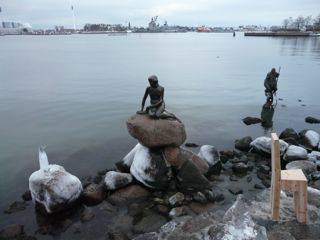
The Little Mermaid presides over Copenhagen harbor, which will provide the cold water for the city's new district cooling plant.
YOUNG: Here’s a cool idea from Copenhagen. As global warming heats up the planet, the city-owned utility plans to cool the Danish capital using an updated version of a century-old technology. The first phase of the new system just went on line. And not only will it enable Copenhagen to dramatically cut the use of air conditioning and reduce emissions of greenhouse gases. At times, it will cool-off the city for free.
Living on Earth Senior Correspondent Bruce Gellerman has our report.
GELLERMAN: Copenhagen’s first electric power plant still stands in the heart of the city. Built in 1892, it generated electricity until the 1970’s. And, ever since, it’s been mothballed waiting for someone to figure out what to do with the old brick building filled with pipes and outdated plumbing. That someone turns out to be engineer, Jan Hoge.

Copenhagen's first power plant.
HOGE: Here you can see we’re in an old power plant. This is the old chimney from the power plant.
GELLERMAN: Oh my gosh, it must be over 200 feet high?
HOGE: Something like that, yes.
GELLERMAN: Wow it’s huge.
HOGE: It’s huge, and old. [Laughs]
GELLERMAN: So they weren’t using this power plant for anything, or it was being used?
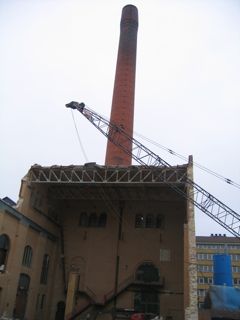
HOGE: It has been used. We have fired coal in here, and then after that it was oil for a period, and then due to environmental reasons – and it was also too small – then they stopped production here in the 70s, and since then it has been used for nothing you can say. So now we can say we use some of the old installations for a new purpose, so we think that’s a good idea.
GELLERMAN: Recycling.
HOGE: Exactly.
GELLERMAN: You’re recycling an entire power plant.
HOGE: [Laughs]
GELLERMAN: But instead of generating electricity, Copenhagen’s old power plant is being converted to produce district cooling, or as Jan Hoge says in Danish:
HOGE: Fjern koling…there you are. [Laughs]
GELLERMAN: Fjern koling?
HOGE: Fjern koling, perfect – you got it! [Laughs]
GELLERMAN: Actually, downtown Denver got it first in 1889, and district cooling – or centralized cooling as it’s sometimes called – is now used in Chicago, Las Vegas, Rockefeller Center in New York City, the U.S. Capital Building in Washington D.C., and it’s especially big in Europe.
HOGE: In our opinion if they can do it in Stockholm, which is a city further north than Copenhagen, and they can do it in Paris, which is further south of Copenhagen, why shouldn’t we do it in Copenhagen?
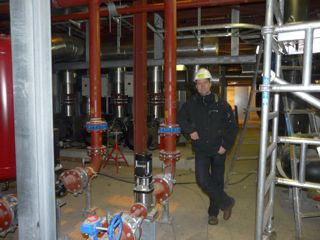
Jan Hoge leans on the pipes that return warm water back into the system. (Photo: Bruce Gellerman)
GELLERMAN: It took a lot of sweat and years of work, but Jan Hoge’s can-do spirit has paid off. Just as district heating has kept Copenhageners warm by capturing and distributing excess heat from generating plants, companies in the city center are now able to connect to a centralized source for cooling.
HOGE: By introducing district cooling we can produce cooling with heat. Sounds crazy but it’s an old technology. Yeah, It works.
GELLERMAN: Let’s go see it.
HOGE: Yes, let’s go do that.
[SOUNDS OF WALKING]
GELLERMAN: We put on hardhats and head inside the old power plant where workers are putting the finishing touches on the district cooling system.
HOGE: As you can see this is a construction site so we’ll have people working here. But the machine here on your left side is an absorption chiller – basically this is only a container; there’s not much technology inside this one.
GELLERMAN: This is really low tech! This is a plumbing job.
HOGE: This is low tech. It’s really simple. It just has to be tight, and a lot of iron. [Laughs]
GELLERMAN: The key to Copenhagen’s district cooling system and what makes it special is that it’s flexible. The plant will use two kinds of absorption chillers. Some are the old tried and true technology that chemically converts waste heat produced by the city’s coal and gas powered plants, and some chillers use electricity. Since Denmark gets a fifth of its electricity from wind power – the largest percentage of any country in the world – when it’s really blowing it can drive the cost of running the district cooling system way down.

Copenhagen’s windmills. (Photo: Jennifer Stevens-Curwood)
HOGE: This might sound a little bit strange but in Denmark we have periods where the electricity is not only zero, it will turn into a price of minus, which means you gain money using electricity – it sounds crazy. So I mean, this is interesting, yes?
GELLERMAN: But what’s really interesting and unique to district cooling Copenhagen-style can be found in the basement of the refurbished power plant.
HOGE: So now you are really in the heart of the cooling center. This is inlet for the seawater system. Inside here you have the pipe coming in and then you have these six pumps circulating the seawater into the cooling center and back into the harbor a little bit warmer.
GELLERMAN: Two pipes, each nearly a yard in diameter, buried 20 feet underground re-circulate water three quarters of a mile from Copenhagen’s harbor. Originally built to cool off the old power plants generators, today the system provides cold water to the new district cooling plant. In winter, fjern koling will be free cooling.
HOGE: If we didn’t have these pipes we didn’t have this project because it would be so expensive for us to put in new pipes in the ground. And although they’re more than a hundred years old they look fantastic. We just have to reline them and now we use the seawater from the harbor to cool down our chiller units, and through the so-called free cooling. And what is free cooling? You produce cold water purely from the water in the harbor.
GELLERMAN: In the winter the carbon footprint from Copenhagen’s district cooling system will be virtually zero. Over the year, CO2 emission will be nearly 70 percent less than traditional air conditioning units and energy costs will be cut 80 percent. And because it’s largely automated, Jan Hoge says the plant will require just one person working eight hours a week to change filters.

An employee puts the finishing touches on the district cooling system. (Photo: Bruce Gellerman)
HOGE: We think this is a good idea. And I also think this could be used other places. The thing is you have to find these resources. You have to find out where do you have resources that otherwise would have been wasted. So maybe in other cities this could be waste heat from the industry. There is a lot of waste heat from industry. Use it for cooling production.
GELLERMAN: This is just the first phase of Copenhagen’s new centralized system…delivering the big chill to the entire metropolitan area will take 15 years and cost a cool 400 million dollars. For Living on Earth. I’m Bruce Gellerman in Copenhagen, Denmark.
[MUSIC: dZihan And Kamien “Gutenmorgenduft” from Gran Riserva (Couch records 2002)]
YOUNG: Coming up – a green homecoming for Veterans.
FARNUM: Over 22 years, I got beat up, banged up, blown up several times. Things just don't work as well as they used to. This helps loosen me up, keeps me somewhat fresh, works my muscles. I'm not stuck behind a computer just yet.
YOUNG: A green homecoming for veterans… that’s just ahead on Living on Earth.
[MUSIC: “Okra And Tomatoes” from Puppet Mischief (ObliqSound 2010)]
Operation Green Energy

Former cavalry scout Michael Farnum pulls up invasive plants. (Photo: George Cavallo)
YOUNG: It’s a recycled edition of Living on Earth – I’m Jeff Young. Many of the soldiers, sailors and marines coming back from Iraq and Afghanistan are finding the return home a hard one. The U.S. Department of Veterans Affairs has treated some 150 thousand returning veterans for post-traumatic stress disorder. And a study by the Rand Corporation found that twice that number--nearly 20 percent--of returning veterans have symptoms of PTSD or major depression.
Many veterans are finding a way to readjust to civilian life via the environment.
We'll hear from young warriors working for cleaner energy, protecting our landscape, and healing their own wounds through contact with the natural world.
We start in Washington State, with an innovative program called the Veterans Conservation Corps. It was inspired by a Vietnam vet from Seattle named John Beal who had thrown himself into the restoration of a polluted stream called Hamm Creek. In this Living on Earth profile from 2000, Mr. Beal explained why he started cleaning up the stream.
BEAL: The last doctor that I had been interviewed by told me that I only had about four or five months to live. And it was right at this place where this pond is, that there was a Kelvinator refrigerator that had gone. It was into sediment about half deep. And I grabbed a shovel from home, came out here, and started digging it out of the stream. This is a mission from God. He gave it to me, 100 percent, woke me up at 2 o'clock in the morning and said, "This is what you're going to do." And I said, "You're out of your mind." And there was a deal struck: I do it, I stay alive.
YOUNG: Despite the doctor’s prognosis, Beal worked 25 years cleaning up that creek he lived to see it support salmon again. He died in 2006. That year, counselor Mark Fischer, who had worked with Mr. Beal, started the Veterans Conservation Corps.
FISCHER: John spent a lot of time recruiting other veterans to do habitat restoration and got a lot of people involved, a lot of folks around the Seattle area involved, and that's kind of how that all came to pass.
YOUNG: Well, what do you think Mr. Beal gained from that work? He was given just a few months to live and ended up living two decades. Was that related to the work he threw himself into?
FISCHER: It’s something we talk about a lot—it’s creating a new mission or purpose in life. The original mission of most military folks is fairly clear to them, and then when they come back into civilian life they don’t really always connect up with another mission and so we try to, in our work, try to help people find a new mission or purpose that gives them that energy to continue on in life and be productive. And usually if they find it, they’re gangbusters; it’s hard to stop them, it’s hard to keep them from going forward.
YOUNG: So now, it’s veterans returning from Iraq, from Afghanistan, and what kind of work are they doing now with your program?
FISCHER: Well, some of them are engaged in volunteer work, but we are really looking at job creation in green fields, as well as other kinds of work. A lot of them are attracted to green jobs, they understand that purpose and that mission is pretty clear to them. So, we have a number of folks who’ve entered colleges in natural resources programs, energy auditing, weatherization, alternative energy—a variety of things that speaks to them in terms of providing a new mission in their life.
The Vet Corps program, it’s really just another example of vets helping other vets, and that’s really what this is about. All my field coordinators who work out in the community are veterans and they just love both nature, but also helping other veterans. So that’s big part of the mission, too.
YOUNG: Just getting outside and working and being surrounded by the smell and the feel of that place. It must just help them come home?
FISCHER: Absolutely. A lot of them talk about that. They’re really happy to be out of the desert, and really happy to be around green and trees and water, and things that smell and taste a whole lot different than what they experienced in Iraq or Afghanistan. So that in itself is welcoming and healing for them.
YOUNG: Mark Fischer of the Veterans Conservation Corps. He says about a thousand veterans in Washington have participated in ecological restoration work so far.
[SOUNDS OF HACKING AND DIGGING AT BUSHES]

Jeremy Grisham clears invasive brush as part of therapy for PTSD. (Photo: George Cavallo)
YOUNG: Producer Tom Banse caught up with three of them hacking away at brambles outside of Tacoma.
FARNUM: My name is Michael Farnum. I’m retired from the United States
Army 22 years, I was a cavalry scout, reconnaissance soldier. We’re doing some invasive species removal in an area in the Nisqually Indian tribe lands. It is just a giant blackberry patch. We’re really close to the highway as you probably can hear.
[SOUNDS OF CUTTING, HACKING “There’s a few salmonberries in there, so be careful...”]
FARNUM: Over 22 years, I got beat up, banged up, blown up several times. Things just don’t work as well as they used to. It kind of hurts to get up in the morning. I eat Motrin like it’s going out of style and try to get through the day. This helps loosen me up, keeps me somewhat fresh, works my muscles. I’m not stuck behind a computer just yet.
[MORE CUTTING SOUNDS]
FARNUM: And, there was another kind of piece that went along with this, they call it eco-therapy. I think a good majority of veterans, combat veterans and non-combat veterans, when they get out, they want some solace, they want some peace.
GRISHAM: My name is Jeremy Grisham. And I served in the Navy for 12 years as a hospital corpsman. Eight of those years I served with the Marine Corps. I was medically retired in 2005 after my deployment to Iraq.
[SOUNDS OF SHOVELING AND RAKING]
GRISHAM: I was diagnosed with post-traumatic stress disorder and major depressive disorder. I guess they’re intertwined. You know, before I was working with the VCC, I would stay at home all the time. I was in a pattern of kind of self-hate and stuff like that. So I was in self-destructive behavior I guess.
Doing this sort of thing, like this sort of labor, gives me a chance to get exercise, a little workout, and kind of let some aggression go, let some steam off or whatever. It just—it’s helpful because when I’m having a bad day, instead of cutting myself or thinking about suicide or something, I have an outlet. Maybe I’ll go chop blackberries and vent some frustration, you know, or maybe just go for a walk. But, it helps me think about other options.
[SOUNDS OF SHOVEL CLINKS IN DIRT]
HANSEN: My name is Phil Hansen. I served in the U.S. Army for ten years. I was in the airborne infantry and then the infantry for about ten years. I got medically discharged in 2006. Finding a support group like the Veterans Conservation Corps with Mark
Fischer has probably been immensely helpful.
Creating a bond with the group of people here now, is kind of going to be a life long bond like I had with my brothers that I had, that I served with in Iraq. Being in a third world country and seeing how they live and then coming back and worrying about your Starbucks in the morning, or something. Then you kind of realize how petty and insignificant that is to living. That’s been a big hurdle for me and a lot of people I know. Yeah, it just puts life into a different context for you.
[SOUND OF CLIPPERS CHOPPING VINES]
HANSEN: Coming through, removing invasives, planting natural shrubs and wildflowers and trees and things like that that belong here in the first place, and having that there’s kind of an instant gratification you get from knowing that you’re creating something that has pretty much been neglected and probably destroyed by us in the past. It’s therapeutical.
MAN: Lunch?
MAN 2: Now on to important business!
[SOUNDS OF FREEWAY FADE]
YOUNG: Members of the Veteran’s Conservation Corps in Washington. Other Veterans are coming home with strong views about the energy we use, and the wars we wage.
[POWER TOOLS]
YOUNG: Works with the company Nexamp, install solar panels on a roof in Lawrence, Massachusetts. Company president and co-founder, Dan Leary looks on.

Dan Leary visits a Nexamp solar installation project. (Photo: Jeff Young)
[LEARY CHATTING IN THE BACKGROUND]
YOUNG: It’s a far cry from Dan Leary’s last job- he was an army captain stationed in Kuwait. Leary said what he saw in the desert left him determined to start a clean-energy company back home.
LEARY: I was. I was. And I think it’s important for our generation to get on top of this because I think anything that we can do to bring better security to our nation is less tasks that, frankly, our children, our grandchildren are going to have to deal with. Energy and water, and a whole number of things that lead ultimately back to…we just have to have much more sustainable practices as a society.
YOUNG: Do you get the sense that your fellow Veterans have had kind of an awakening about energy issues?
LEARY: I think that we all have. I think that the Veterans have been able to see it first hand-what is sustainable and what’s not sustainable. As soon as you’ve seen a massive desalinization plant running on oil that has to be pumped from thousands of feet below the ground to sustain large populations, you understand just how fragile the whole system is. And I think that’s what Veterans certainly understand first-hand. And the more that we can generate on site, it does things, more than just national security, it’s really just the right thing to do.
YOUNG: Leary’s not alone in that thinking. A recent poll of Iraq and Afghanistan Vets found an overwhelming majority see our energy policy undermining national security. And just over 70% support policy changes to promote clean energy and address climate change. The poll was sponsored by the group Vote Vets, which is also part of a rolling public outreach program called Operation Free.
[BUS NOISES]
YOUNG: Operation Free’s bus, powered by biodiesel, has rolled through 22 states so far…drumming up support for legislation on clean energy and climate change. We got on the bus to talk with Army Vet Robin Eckstein of Wisconsin, Marine Vet Matt Victoriano of Arkansas, and Navy Vet Wade Barnes of Massachusetts. Barnes says he had an epiphany while watching his ship refuel.

Former Army truck driver Robin Eckstein. (Photo: Operation Free)
BARNES: It takes on one million gallons of diesel fuel at a shot. When you watch diesel fuel flow through a one and a half foot diameter pipe for four hours under high pressure, and you realize that’s something that’s done every seven-ten days, it doesn’t take a lot to kind of extrapolate that out and think about that same fuel going into our fuel pumps into our vehicles, things like that. And when I learned through Operation Free that we’re really transferring one billion dollars a day overseas to fuel our oil addiction, it really hammered it home. That really was probably the turning point for me.
YOUNG: Robin…same question for you: what was it about your experience in Iraq that you think motivated what you’re doing now?
YOUNG: Robin, same question for you, what was it about your experience in Iraq that you think motivated what you’re doing now?

Former Marine, Matt Victoriano. (Photo: Operation Free)
ECKSTEIN: I was part of the logistical nightmare that the military deals with because of our energy policy. I drove in convoy’s everyday all around Baghdad, hauling fuel and water. And every time I left the gates of Baghdad International Airport, it was a roll of the dice of what I was going to encounter that day. You know whether it was going to be sniper fire, ambushes, you know, IED’s, was anyone going to be shot or killed so that I could be this huge slow moving target, hauling this fuel and water to get to these various outposts. I mean, if these other forward operating bases had solar generators, that’d be less missions that I would have to pull! And so it was really important for me to make sure that we move in that positive direction because I don’t want to see other truck drivers in the future having to die over something that, you know, we can do something about.
YOUNG: I think a lot of people will understand the connection with dependence on foreign oil undermining our national security, but climate change might not be so obvious. How do you explain that to people?
ECKSTEIN: You know, as far as climate change goes, I listen to my chain of command. The Pentagon, the DOD and the CIA are all onboard with this. They’re saying it’s true, and I’m sorry, but the CIA isn’t known for huggin’ trees and savin’ polar bears. They specifically list climate change as an accelerant to the instability of nations. Currently we can see it in Afghanistan and Somalia where climate change has disrupted these areas that were already unstable in the first place, it’s accelerated the problems with famine and drought, and the area has become breeding grounds for terrorists.

The biodiesel Operation Free bus has crisscrossed the country to spread the veteran-based message of energy independence. (Photo: Operation Free)
YOUNG: You know, the conversation around climate change and the cap and trade type approach to dealing with greenhouse gasses…it’s become very politicized. Do you think that, I don’t know, that you’re sort of able to do an end-run around the partisanship that’s become associated with this issue, because you’re approaching it as Veterans?
BARNES: Our message gets a lot of traction because we are Veterans. But I also truly believe that this issue transcends partisan politics. And when you come at this from a national security standpoint, you’re talking about an issue that everyone can get behind.
ECKSTEIN: This isn’t a left issue, this isn’t a right issue- this is an American issue. We want to secure our energy future and make America number one again. And we can do that by passing comprehensive clean energy legislation.
YOUNG: The bus stops at an American Legion hall in Wrentham, Massachusetts, where a few dozen people, mostly men in their 50’s and up, sip coffee and listen to Robin. She tries to bridge the generation gap here with a reference to World War II.
ECKSTEIN: America really came together during World War II. People were, at their own home, creating these victory gardens. Wouldn’t it be great if we could have our own victory gardens by having these solar array fields, by having these wind turbine places, have those be our victory gardens. Have that energy be here in the United States, that money here, those jobs here.
YOUNG: Peter Baker who calls himself a Cold War Veteran, speaks up.
BAKER: I run a small little business and I could easily re-tool to make solar panels. There are some things going on and I’m proud of my country. I want it to stay proud! I don’t know what the heck to tell my grandchildren. I don’t know what to tell my son, what to do, where to go. Well that’s something where we can get onboard. And that’s what we’re here for, to get people off their duffs and do something about it. Thanks.
[APPLAUSE]
YOUNG: After a lively Q&A period, it’s back on the bus and on to the next town. Matt Victoriano says the response in Wrentham is typical of what he’s hearing from people around the country…deep concern about national security and economic uncertainty, and a general anxiety about where the country is headed.
VICTORIANO: They have a hard time looking at their grandkids and making sure that they’re going to be secure when they grow up and have kids on their own. We spend billions and billions of dollars on oil subsidies, on foreign jobs. We get 60 percent of our oil from overseas. We have a manufacturing sector that has dwindled. They see the jobs going overseas and they say ‘what can we do?’ and this absolutely is a way to bring those jobs back, bring the money back. They hear a message and they can go home and tell their grandkids, ‘yeah, there is hope for you in the future.’
YOUNG: Do you see this as a sort of continuation of your service to your country?
VICTORIANO: We didn’t stop our service to the country, once we took off our uniform. We carry that same patriotism, that same dedication, in our hearts wherever we go. I did see, you know, 19-year-old marines crying with holes in their body and blood coming out, and it’s my responsibility to keep on doing what I can to protect them and look out for them and make sure that their best interests are always taken into account. All Veterans want to keep on serving their country once their service in the military is out, and this is… you can’t find a better way to do it than this.
[BUS DRIVING AWAY]
Related links:
- Veterans Green Jobs
- Veterans Conservation Corp
- Operation Free
- Vote Vets
YOUNG: There's more about these Veterans programs and green jobs for Vets at our web site l-o-e dot org.
[MUSIC: Daniel Lanois "O Marie" from Acadie (daniellanois.com 2005)]
The Language of Landscape

YOUNG: Time now to dip into our collection of evocative terms about the land around us. They come from the book "Home Ground: Language for an American Landscape", compiled by Barry Lopez and Debra Gwartney. Today, poet Pattiann Rogers tells us about something rapidly changing the landscape of the south: here’s her description of the wild and spreading plant "kudzu."

homeground
ROGERS: Kudzu. In large portions of the southeastern United States, the Kudzu vine, rapacious and fast-growing, has overtaken the countryside, covering Dixie like the dew. Growing sixty feet or more in a season, this woody, hairy vine, originally a native of Japan and China can completely engulf large trees, telephone poles, abandoned cars, small sheds, little-used country roads. Kudzu is believed to cover more than seven million acres of rural areas in the south, and has been found as far north as New York, as far west as Texas, and commonly in the mid-West, including Ohio, Indiana, Illinois, Missouri and Kansas.
Luckily, winter frost kills the vine, although it’s roots survive.
People residing in Kudzu country have adopted the vine good-naturedly as an emblem of their home place, and enjoy telling tall tails about it. For example, there’s the one about an escaped prisoner who fled into a Kudzu patch and is still unaccounted for.
The Kudzu Kings, a musical outfit, advertise themselves as the purveyors of southern-roots-rock-drunken-country-jungle-boogie-Americana from Oxford, Mississippi.
Related link:
The Home Ground Project
[MUSIC: Kudzu Kings: “Truly” from Kudzu Kings (CD Baby/Kudzu kings 1997)]
Poet Pattiann Rogers lives in Castle Rock, Colorado. Her definition of “kudzu” appears in the book: "Home Ground: Language for an American Landscape" edited by Barry Lopez and Debra Gwartney.
YOUNG: In just a minute – The walrus sings…Goo goo g'joob. Stay with us at Living on Earth.
[MUSIC: Jacob Fred Jazz Odyssey: “David” from Stay Gold (Royal Potato Family Records 2010)]
Science Note/Tree Power
YOUNG: You’re listening to a recycled edition of Living on Earth. I’m Jeff Young.
Just ahead – natural history takes flight with an antique egg collection. But first this Note on Emerging Science from Nirja Parekh.
[SCIENCE NOTE THEME]
PAREKH: The maple is already famous for its deliciously sweet syrup, but new technology could make the trees a sweet spot for energy, too. Research from the University of Washington shows big leaf maples can run an electrical circuit. The scientists found that the trees can produce a stable voltage of up to a few hundred millivolts, if they stick one electrode into the tree and one electrode into the soil.
This process sounds similar to popular kid’s science fair experiments like the potato or lemon battery. These generate an electrical current through a chemical reaction that moves electrons between electrodes from two different metals. Tree power uses a different mechanism, with electrodes of the same metal and, most importantly, it relies on a device called a boost converter. This tiny, ingenious, custom-built gadget stores the tree’s miniscule voltage, and concentrates it into a larger, usable output. But don’t run out to your backyard and try to plug in your iPod. The tree power can’t support regular electronics, but it can run low-power sensors.
These could be engineered to monitor environmental conditions and detect forest fires in the area. Researchers say they are not certain where the voltage comes from, but say it might prove useful if it could be harnessed to check on the overall health of the tree. That’s necessary as climate change impacts the places where the maple tree thrives. That’s this week's note on emerging science. I’m Nirja Parekh.
Related link:
University of Washington Press Release
[THEME]
Discovering Walruses
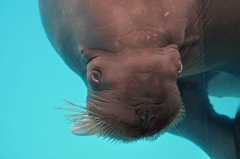
Sivuqaq the walrus might not look like the musical type, but his trainers know better. (Photo: Nancy Chan, Six Flags Discovery Kingdom)
YOUNG: The walrus is one the world's most mysterious mammals. Its habitat is less than hospitable for researchers. Much of what scientists do know about them comes from the native people who hunt them. One very little known fact is that walruses are musical -- their songs are some of the longest and most complex in the animal kingdom. Now climate change is adding urgency to walrus research.
In Vallejo, California, researchers hope the secrets of walrus breeding songs can help preserve the species. Matthew Brunwasser reports – and a warning—Matthew’s report has some frank descriptions of walrus reproduction.
[WALRUS ROAR]
BRUNWASSER: Now is a trying time to work at the walrus tank at the Six Flags theme park. Trainer Toni Rael introduces me to Sivuqaq, a 2,400 pound male pacific walrus who lives here. He’s about the size of a Honda Civic. Rael says he is being obnoxious, like a guy in a bar.
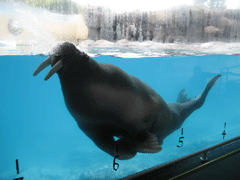
Sivuqaq in his tank. (Photo: Matthew Brunwasser)
RAEL: Well Sivuqaq thinks it breeding season. So right now, he is in his rut, male walruses go thru a rut behavior where they will make a lot of different vocals to solicit females and try to get the girls’ attention. However, the females have already been through their cycle and are no longer in season, so they’re done with him. [laughs]
[WALRUS ROAR]
RAEL: So now he’s soliciting everyone else he can find. [laughs]
BRUNWASSER: The park is trying to breed Sivuqaq with its two female walruses. But no luck so far. Rael says they haven't quite figured out how to get him in the mood at the same time as the females. He also seems a bit confused.
RAEL: Strange things at different times seem to get him excited. He seems to like anything at the lower windows. We have had a new recycle bin that we put at the window; he really liked that for awhile. Anything different, strollers, people, anything power-tool related.
[SPLASHING SOUND; WALRUS ROAR]
BRUNWASSER: Sivuqaq and the two females came to the park when they were only a few months old, after being orphaned in a hunt in Alaska. All are unrelated. And none grew up with adult walruses. So their behavior is an ad hoc mix of instinct and learning in captivity. Holley Muraco is a reproductive physiologist researching walruses at the park. She says little is known about walrus breeding in general.
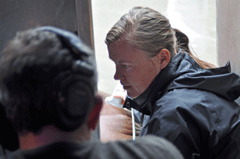
Holley Muraco does ultrasound on a female walruses, checking her ovaries. (Photo: Nancy Chan, Six Flags Discovery Kingdom)
MURACO: There’s only been ten walrus calves ever born in zoological facilities, so that's pretty significant. They are very sexual animals, they live long lives in zoos, but for some reason we not getting a lot of babies. So clearly something is missing.
BRUNWASSER: Muraco says weather, temperature and sunlight could be factors, since the Bay Area is mild year-round. She is also checking hormones, and monitoring body fluids regularly, in both Sivuqaq and the females, to find the triggers for their breeding behavior. She says she wants to collect the first walrus sperm sample ever taken. A healthy batch would be valuable for study and could also be used to artificially inseminate one of the females. She holds up a special tube-shaped instrument.
MURACO: This is the artificial vagina, and it's basically a PVC pipe. It has got thick rubber on either end of it, so that there’s no sharp edges. We will train him to put his penis inside there and hopefully we will figure out what exactly the trigger is that’s going to make him feel comfortable enough to give us a sample.
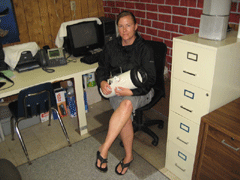
Reproductive physiologist Holley Muraco, with the artificial walrus vagina. It has a handle and a valve so it can be filled with warm water. (Photo: Matthew Brunwasser)
BRUNWASSER: The park will then build a mount for the artificial vagina and hope that Sivuqaq takes a liking to it. There are still many surprises when you are dealing with walrus sexuality. The walrus, like many mammals, has a baculum, or penile bone. Researchers say it's an impressive sight.
MURACO: It's about three feet long. The native people use the walrus penis bone as walking sticks, they use them as clubs, in the past. And it’s a pretty remarkable, definitely a pretty remarkable structure.
[WALRUS ROAR]
BRUNWASSER: Another extraordinary attribute of male walrus behavior is their musicality. Through a viewing window, research biologist Colleen Reichmuth is observing and filming Sivuqaq’s displays and vocalizations underwater.
REICHMUTH: Three, two, one, go
[KNOCKING SOUNDS]
REICHMUTH: This is Sivuqaq track number three. He’s at two and a half meters, head up, filling the sacks, producing some bell-like sounds, moans at two and a half, double knock, some low amplitude moans.
BRUNWASSER: Reichmuth is gauging the strength of Sivuqaq’s sounds.
[WALRUS MOANS]
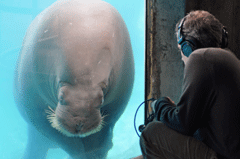
Reporter Matthew Brunwasser records Sivuqaq. (Photo: Nancy Chan, Six Flags Discovery Kingdom)
BRUNWASSER: He claps his flippers in the water as part of his display. You can hear it loudly even through the 4-inch thick window of the tank. Here it’s also amplified through a speaker.
REICHMUTH: You know, walruses are some of the most amazing animal in terms of their acoustics because they can make sounds with all different parts of their body.
BRUNWASSER: Walruses are piniped beatboxes, clapping, moaning, whistling and making bell sounds with an air sack in their necks.
REICHMUTH: An important sound that we should hear today is called the knock. It’s a really loud knocking noise he is making inside his forehead without releasing any air. And we’re not really sure, you know, how he is manipulating his anatomical structures to make such a loud noise.
[WALRUS KNOCKING]

Sivuqaq the walrus might not look like the musical type, but his trainers know better. (Photo: Nancy Chan, Six Flags Discovery Kingdom)
BRUNWASSER: To try to find out, Reichmuth rejoins Sivuqaq face to face upstairs. Leah Coombs is a master walrus trainer, has known Sivuqaq since he was a baby.
[WALRUS KNOCKING]
COOMBS: Knock, knock, good.
[WALRUS KNOCKING]
BRUNWASSER: Reichmuth puts her hand into his mouth to try to feel where the sounds are coming from. The display is followed by a surprise blown from his nose.
[THE SOUND OF A WALRUS EXPELLING SNOT]
COOMBS: What is that?!
[LAUGHTER]
BRUNWASSER: Sivuqaq is clearly still learning to sing. In the wild, the knocks of male walruses are far more developed.
[WALRUS KNOCKING]
BRUNWASSER: This might sound like a German industrial band from the 1980s. But this is a wild walrus, recorded in the Canadian high arctic. Underwater. The sounds are so loud and sharp they can be heard above the sea ice and underwater more than 5 miles away.
[WALRUS KNOCKING]
BRUNWASSER: This medley of breeding sounds includes knocks and bells.
[WALRUS KNOCKS AND BELLS]
BRUNWASSER: Scientists can only hope they figure out these mustachioed enigmas quickly enough to keep up with the pace of arctic climate change. Joel Garlic-Miller is a walrus biologist at the U.S. Fish and Wildlife Service in Anchorage. He says a warming Arctic is bad news for walruses because they prefer to live on floating sea ice.
GARLIC-MILLER: If you look at long-term data sets of sea-ice thickness and extent, we’ve seen some very substantial declines in both the area covered by sea ice and sea ice thickness over the past 20 years.
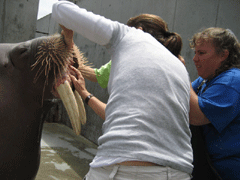
Reichmuth tries to feel where the knocking comes from in Sivuqaq’s head by putting her hand in his mouth.
BRUNWASSER: When the sea ice disappeared in the summer of 2007, thousands of walruses hauled up on the Alaska coast for the first time. The skittish animals have no experience with people, cars or airplanes, and are prone to stampeding and trampling, which can kill juveniles. Wild walruses are almost never seen by humans, unlike polar bears, which live close enough to people to eat from their garbage cans. Garlic-Miller says no one has ever been able to count how many walruses there are.
GARLIC-MILLER: They inhabit a vast, remote inaccessible habitat. Probably the most remote area on the planet and most difficult to access. Shifting sea ice, over thousands and thousands of square miles, many hundreds of miles offshore is where they prefer to distribute themselves.
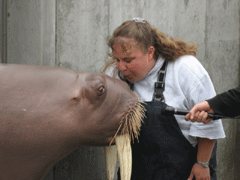
Walruses like it when you blow in their nose; this is how they “meet” each other. (Photo: Nancy Chan, Six Flags Discovery Kingdom)
BRUNWASSER: So U.S. and Russian scientists began the first serious population survey of the Pacific walrus in 2006. The findings should be ready soon.
GARLIC-MILLER: It's been quite a challenge to get some very basic biology about them.
BRUNWASSER: Walruses are not currently listed as threatened or endangered. But due to diminishing sea ice, U.S. Fish and Wildlife was petitioned to consider listing them. A decision is expected in the fall of 2010.
For Living on Earth, I’m Matthew Brunwasser, in Vallejo, California.
YOUNG: Since this story first aired the large male walrus at Six Flags Discovery Park has undergone fertility treatment to get him in sync with the females’ cycles… and it appears to be a success! Although she won’t know for sure until sometime this fall, Holley Muraco says she’s hopeful that one of the female walruses is already pregnant.
[MUSIC: Colin Towns Mask Orch. “I Am the Walrus” from Another Think Coming (Provacatuer Records 2004)]
Bird Eggs Unhatched
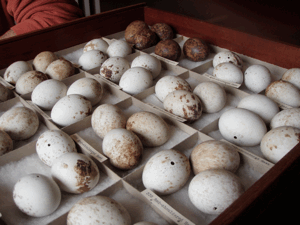
(Photo: University of Connecticut)
YOUNG: When Farmington, Connecticut's Barney Library undertook a major renovation last year, staff decided to get rid of some very fragile stuff - 8,000 birds’ eggs. The egg collection was donated in 1924, and has been stored in a closed cabinet on the library's second floor ever since. The Library donated the egg collection to the University of Connecticut's Biodiversity Research Collections. Producer Laurie Sanders was there on moving day and has our story.
WOMAN: Hey Tanner, don’t forget to dig out the batting from underneath the box, OK?
SANDERS: It’s 9 in the morning, and a small group of grad students and faculty from UCONN has just arrived at the Barney Library in Farmington, Connecticut.
[SOUNDS OF SOMEONE CLIMBING METAL STAIRCASE]
SANDERS: The crew uses a back staircase to reach a second floor meeting room. It’s here inside a special wooden cabinet that an enormous collection of wild bird eggs has sat for decades.
RUBEGA: It’s a beautiful piece of furniture, but it’s really not secure storage from the point of view of modern specimen storage.
SANDERS: Margaret Rubega is Connecticut’s State Ornithologist, and a biologist at UCONN.
RUBEGA: It’s truly stunning the condition this collection is in. It really has survived through benign neglect and the protection of being in an institution like a library.
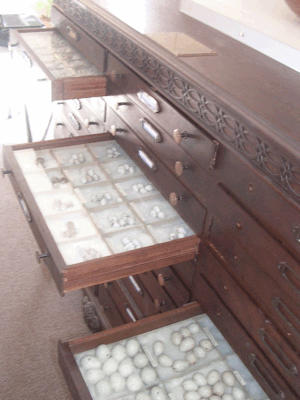
The Barney Library in Farmington, Connecticut housed this bird egg collection for more than 80 years. They recently donated it to the University of Connecticut’s Museum of Natural History. (Photo: University of Connecticut)
SANDERS: Egg collecting was a wildly popular hobby in the 19th century. But Rubega says this collection is extraordinary.
RUBEGA: It’s a big collection. It’s fully documented, and especially what’s important for us as an institution of the state, is that the vast majority of eggs in this collection come from Connecticut. It’s a physical library of the birds who were in Connecticut in the 19th century. The habitat has changed, the bird life has changed, the conditions under which the birds are trying to make a living and reproduce has changed. It’s just an unbelievable record of what the bird life in this state used to be.
[SOUND OF DRAWER OPENING]
SANDERS: Rubega slides a drawer open. The eggs are beautiful, meticulously organized and labeled. Grackles. Red winged blackbirds. There is a whole drawer full of tiny hummingbird eggs. Several others contain just warbler eggs. In the deeper drawers are the bigger eggs—those of owls, gulls, hawks, falcons, herons. When 19th century collectors took eggs, they didn’t take just one. They took whatever was in the nest. Then they drilled a tiny hole in each egg and removed the yolk and egg white. Rubega opens drawer after drawer. It’s like a treasure chest, filled with glossy white, blue, pale brown, buffy green. Harry Curtiss Mills amassed this collection. He was an electrician, born in the 1860s, and like many people in the late 19th century, he was passionate about natural history. He and his wife had collections of rocks, butterflies, wildflowers, shells. But all of these were surpassed by his collection of bird eggs.

Red-shouldered hawk eggs with penciled set marks, and holes that were drilled to remove the egg contents. (Photo: University of Connecticut)
[SOUNDS OF ROOM, PEOPLE SPEAKING]
SANDERS Over the course of 50 years, Mills collected, traded and bought thousands of eggs, representing 840 species.
[RUBEGA SPEAKING]
SANDERS: Before removing the drawers of eggs from the cabinet, the team goes over how they’ll record the information in a database, and how they’ll move, pack and protect the eggs in their new museum containers.
RUBEGA: So if you look take a close look at this first clutch of eggs, penciled on it, near the hole usually, is the set mark that the field collector would have recorded on the data card. Go ahead gather round and see if you can see the number.
SANDERS: They take a couple photos of the cabinet, and then they take the first real step. They take OUT the first drawer.
[SOUND OF DRAWER OPENING]
SANDERS: And then they take off the glass sheet that’s been covering the eggs for 85 years.
[SOUND OF MOVING GLASS]
RUBEGA: There it is! Let’s take a picture.
SANDERS: The team begins to carefully duplicate the information Harry Curtiss Mills penciled on each egg into a database.
[TYPING ON KEYBOARD]
STUDENT: Set mark is two over four, there are four eggs, species is four 66 A.
SANDERS: Egg collecting became illegal in America in 1918, with the passage of the Migratory Bird Treaty Act. The practice had taken a toll on bird populations, especially some rare species. Rubega says a well-documented, extensive collection like this one now can play a valuable role. It shouldn’t just remain a curiosity shown off in a parlor.
.gif)
Susan Hochgraf, Vertebrate Collections Manager of the Ecology and Evolutionary Biology Research Collections at University of Connecticut, takes a close look at osprey eggs. (Photo: University of Connecticu)
RUBEGA: The scientific value of this collection is sort of easiest to understand if you think about the collection exactly the same way that you think of about the collection of books in a library. In every single one of these eggs, there’s information about what the world was like at the time the egg was collected.
SANDERS: Rubega says collections make it possible for scientists to answer questions they didn’t even know they were going to have—like investigating the impact of acid rain or climate change, or the presence of environmental contaminants. Years ago, old egg collections like this one proved crucial in linking the thinning of eggshells to DDT.
Right now, a graduate student at UCONN is studying the relationship between cadmium levels and declining populations of American woodcock. Rubega says he’s chomping at the bit to analyze these eggs and compare cadmium levels from a century ago to those seen in woodcock eggs today.
STUDENT: Chestnut-sided warbler. On every egg is written 659, and on the group of four eggs is written…
SANDERS: The eggs are now in a collection at UCONN and available to anyone who wants to see them. For Living on Earth, I'm Laurie Sanders.
Related link:
UConn Bird Collections
[MUSIC: John Ellis “This Too Shall Pass” from Puppet Mischief (ObliqSound Records 2010)]
YOUNG: On the next Living on Earth. Katrina took their homes, BP’s oil took their livelihood. But this village remains.
PHILIPPE: This is our place in the universe; this is where the creator set us down. In spite of all the impacts that have come at us both natural and human induced, we’re still here. This is where we belong.
YOUNG: Hanging on in Grand Bayou. That’s next time on LOE.
YOUNG: We leave you this week at the Vancouver waterfront. Waves lap against a creaking wharf while the Seabus ferry crosses Vancouver Harbor. Passengers shuttle between the city of North Vancouver and downtown.
Barry Truax and Hildegard Westerkamp captured these sounds for the CD Soundscape Vancouver 1996.
[SOUND OF SEAPLANES, CREAKING METAL, FOGHORN]
YOUNG: Living on Earth is produced by the World Media Foundation. Our crew includes Bobby Bascomb, Eileen Bolinsky, Bruce Gellerman, Ingrid Lobet, Helen Palmer, Jessica Ilyse Smith, Ike Sriskandarajah, and Mitra Taj, with help from Sarah Calkins, and Sammy Sousa. Our interns are Amanda Martinez, Meghan Miner and Amie Ninh. Jeff Turton is our technical director. Alison Lirish Dean composed our themes. Steve Curwood is our executive producer. You can find us anytime at loe dot org – and check out our facebook page – PRI’s Living On Earth. I’m Jeff Young. Thanks for listening.
ANNOUNCER: Funding for Living On Earth comes from the National Science Foundation supporting coverage of emerging science. And Stonyfield farm, organic yogurt and smoothies. Stonyfield pays its farmers not to use artificial growth hormones on their cows. Details at Stonyfield dot com. Support also comes from you, our listeners. The Ford Foundation, The Town Creek Foundation, The Oak Foundation—supporting coverage of climate change and marine issues. And Pax World Mutual Funds, integrating environmental, social, and governance factors into investment analysis and decision making. On the web at Pax world dot com. Pax World for tomorrow.
ANNOUNCER 2: PRI – Public Radio International
Living on Earth wants to hear from you!
Living on Earth
62 Calef Highway, Suite 212
Lee, NH 03861
Telephone: 617-287-4121
E-mail: comments@loe.org
Newsletter [Click here]
Donate to Living on Earth!
Living on Earth is an independent media program and relies entirely on contributions from listeners and institutions supporting public service. Please donate now to preserve an independent environmental voice.
NewsletterLiving on Earth offers a weekly delivery of the show's rundown to your mailbox. Sign up for our newsletter today!
 Sailors For The Sea: Be the change you want to sea.
Sailors For The Sea: Be the change you want to sea.
 The Grantham Foundation for the Protection of the Environment: Committed to protecting and improving the health of the global environment.
The Grantham Foundation for the Protection of the Environment: Committed to protecting and improving the health of the global environment.
 Contribute to Living on Earth and receive, as our gift to you, an archival print of one of Mark Seth Lender's extraordinary wildlife photographs. Follow the link to see Mark's current collection of photographs.
Contribute to Living on Earth and receive, as our gift to you, an archival print of one of Mark Seth Lender's extraordinary wildlife photographs. Follow the link to see Mark's current collection of photographs.
 Buy a signed copy of Mark Seth Lender's book Smeagull the Seagull & support Living on Earth
Buy a signed copy of Mark Seth Lender's book Smeagull the Seagull & support Living on Earth

